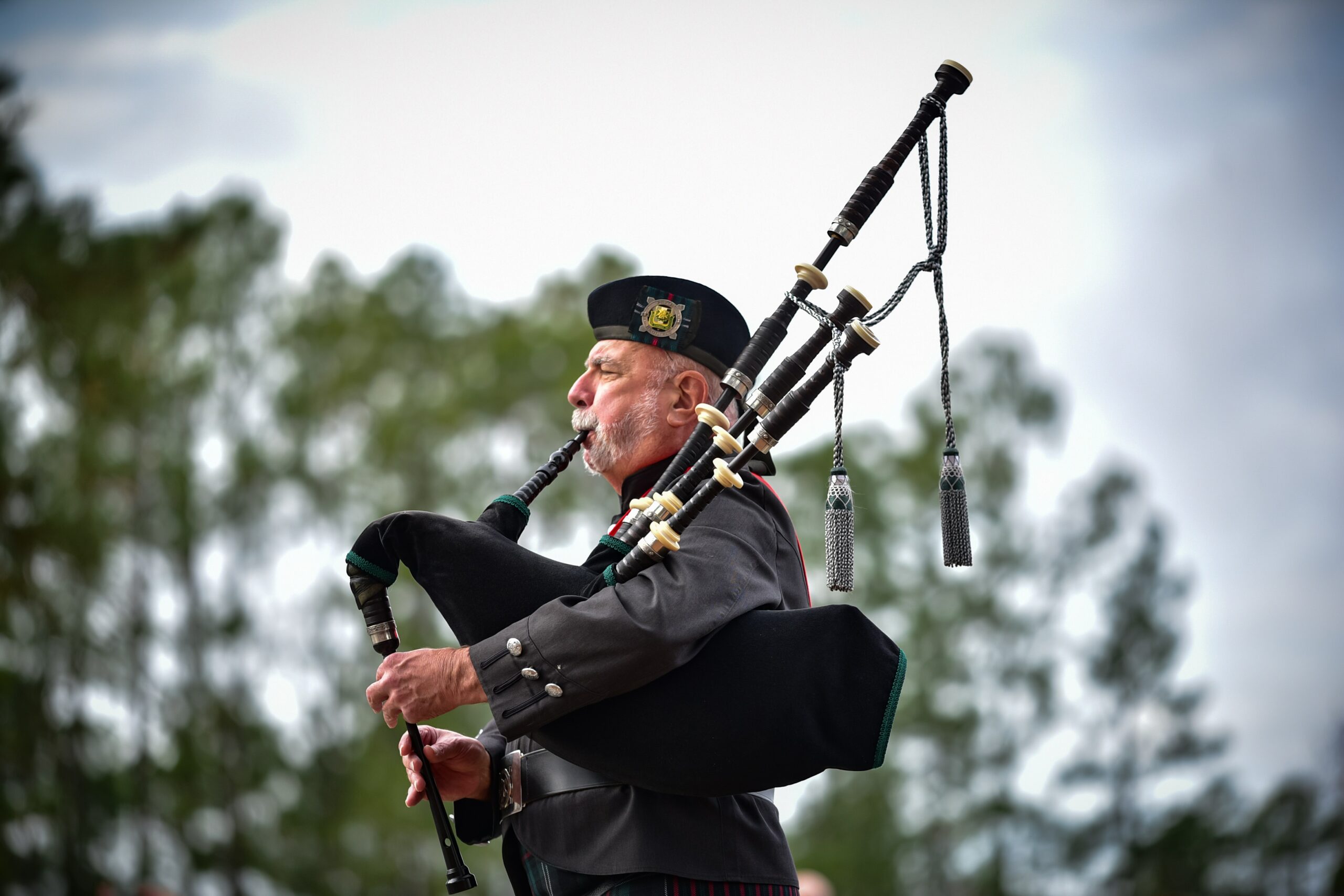How Do Bagpipes Work?
For anyone who wants to know how bagpipes work, it opens up a portal into one of the oldest and most formal instruments found anywhere on the planet.
Bagpipes produce sounds by moderating the airflow in the instrument’s bag via the pipes or reeds the piper blows into. This vibration can be modulated with the drones and chanter pieces, but air most be constantly flowing into the bag.
Bagpipes aren’t a gimmick instrument. They have long been associated with many important occasions. This ranges from royal coronations to signaling epic war chants.
Despite there being forms of the instrument found worldwide, the basic mechanics always stay the same. It’s why these drones are so familiar when they are played. So how do bagpipes work?
How Bagpipes Work: A Breakdown
Bagpipes are a woodwind instrument that is a strange cross between a recorder and an accordion. This peculiar blend works in how it is played and how it sounds.
The iconic wails and drones result from how each part of the instrument’s parts are manipulated. The main components of the bagpipes are:
- Airbag
- Chanter
- Reeds
- Drone
As the piper varies his position and breath control, it alters the sound from the bagpipe. It’s how they can quickly change the pitch and tone of the instrument almost instantaneously.
What does each part of the bagpipe do?
When learning how bagpipes work, you need to understand what role each part of the instrument plays in producing the iconic sound. It’s a simple mechanic that requires delicate refinement to master.
Airbag
The airbag is what the name suggests. An ample internal space acts as a vacuum for air blown into it.
Often made from animal skin, the bag must be completely airtight to produce any prolonged sounds or noise. This is usually done by stitching multiple layers to boost durability.
You will also find that some airbags have moisture traps woven inside. This prevents mold from damaging the inner linings and the piper from inhaling nasty bacteria or spores.
Chanter
The chanter pipe is the main pipe that players blow into when playing the bagpipes. It is shaped and played like a recorder. The pipe itself is long and cylindrical, with holes throughout its body.
As the piper blows down the pipe, they use their fingers to cover and move across the holes to moderate the airflow into the airbag.
As this airflow is manipulated on the chanter, the air pressure expands or reduces depending on how many holes are covered.
Depending on the type of bagpipe, the instrument will usually have either one or two chanter pipes to have at their control. This changes the tone and sound as it is played.
Reed
Like all woodwind instruments, bagpipes have reeds installed at the top of the chanting piece. Acting like a mouthpiece, the reed generates vibrations that travel down the pipe.
These vibrations react with the air blown into the pipe and stored in the bag to create different sounds. As air is blown into the instrument, the reed vibrates to cause sound.
Drone
To help give sustained sounds, bagpipes also have a drone pipe to maintain a constant sound. Although shaped like the chanter pipe, the drone pipe has no finger holes and is left unplayed during a performance.
With no room to manipulate or produce added airflow, the sounds generated from this pipe are constant. Drone pipes will also have a reed at the top to generate vibrations and create sounds to flow back into the airbag.
To prevent clashing sounds with the chanter pipe, drone pipes can have a tuning screw inserted to set a particular sound. The drone pipe is often tuned and set to several octaves lower than what is produced in the melodic pipes.
What are the different types of bagpipes?
Despite all bagpipes sharing a standard shape and structure, they also come in all shapes and sizes. These variants alter from region to region and change slightly how you may understand how bagpipes work.
It only takes a quick look at different versions from around the world to understand how many types of bagpipes there are. So what are some of the common bagpipes used around the world?
Highland Bagpipes
The Highland Bagpipes are what springs to mind when you hear the iconic drones. Originating from Scotland, these are one of the larger bagpipe variants altogether. And it is this more exquisite design that helps create such a unique sound.
For starters, the Highland bagpipe has no less than four separate pipes. This is done by having two pipes to manage tenor levels and one for bass notes. Furthermore, the chanter pipe has nine holes tuned to nine different notes, allowing complex tunes to be played.
This elaborate design has seen the Highland Bagpipes used widely in ceremonial roles. Some of these roles have included processions in military units and functions in royal coronations. It’s a role that is still used in British society to this day.
Uilleann
Hailing from Ireland, the Uilleann differs significantly from its larger Scottish cousin in design and playing style. The Uilleann bagpipe is much smaller than Highland Bagpipes, and the sounds are generated by a set of bellows that regulate airflow – even when the piper is not blowing into the instrument.
It also has the holes on the chanter pipe manipulated more horizontally. With the lowest hole almost always closed off by the finger, the notes escape the top holes producing shorter sounds.
Like its Scottish cousin, the Uilleann has three pipes that regulate sounds and allow the piper to produce harmonic and rhythmic sounds. You will likely find the Uilleann used in folk music and local events rather than national ceremonies.
Gaita
Found in both Spain and Portugal, the gaita is one of the slimmest bagpipe variants. It has a unique design, with pipes on different sides of the airbag. For example, the drone pipe is located on the underside of the airbag, and the chanter pipe is twice the size of the two drone pipes.
With the smaller drone pipes and spaced-out design, they are known for producing a higher sound than many of their bigger cousins. You will find Gaitas used in both Northern Spain and throughout Portugal- mainly at local cultural festivals.
Gaida
Built and used throughout the Balkans, the Gaida is about as basic as it gets in terms of bagpipes. The Gaida has just two pipes – one chanter and one drone pipe. On the Gaida, the chanter pipe has a unique slot on the top of the body called a “flea hole.” When covered, this hole bumps notes up half a pitch requiring more finesse.
The Gaida is common throughout South-Eastern Europe and used in countries such as Serbia, Greece, Macedonia, and Bulgaria. Each region has slight variations in sound. However, you will find that the design often remains the same.
Despite having a similar name, it is different from the Gaita.
Smallpipes
As the name suggests, smallpipes are a much smaller – and technical – version of traditional bagpipes. Many smallpipes, such as the Northumbrian bagpipes, have chanter and drone pipes to produce sounds. However, the sounds are manipulated by tuning keys to make different notes.
Smallpipes can have 7-17 tuning keys on a set of pipes. The more keys added to a pipe, the higher range of octaves a set of pipes can reach. Smallpipes are much more ceremonial but are throughout Europe and the Middle East.
Electric Bagpipes
Like any instrument, even bagpipes couldn’t escape electrification. Electric bagpipes are a recent innovation, with the first models created in the early 2000s.
Using pickups to detect vibrations from the reed, electric bagpipes project their sound through an amp to amplify their sounds. Electric bagpipes come in all shapes and sizes and are often custom modifications created by experienced pipers for their means.
How To Play The Bagpipes
Basic Techniques
To begin learning how to play the bagpipes, it is essential to familiarize oneself with the fundamental techniques that underpin the instrument’s unique sound. New learners should start with practices like:
- Fingering Techniques: Understanding the correct positioning of the fingers on the chanter to produce different notes.
- Blowing and Squeezing: Learning the art of blowing into the bag continuously while squeezing it to maintain a steady pressure, which is crucial in producing a constant sound.
- Posture and Handling: Knowing how to hold the bagpipes properly to avoid muscle strain and facilitate easy playing.
Understanding Bagpipe Notation
The bagpipe music notation is slightly different from the standard music notation. It comprises of:
- Staff Notation: Bagpipes usually employ the standard staff notation, but with a restricted range of notes.
- Gracenotes: These are quick, auxiliary notes used to embellish the melody and to articulate notes.
- Complex Melodic Patterns: The notation often involves complex melodic patterns which are integral in producing the characteristic sound of bagpipes.
The Grace Notes and Embellishments
In bagpipe music, grace notes and embellishments add depth and sophistication to the music. These include:
- Grace Notes: Quick, secondary notes that give a kind of “ornament” to the primary melody notes.
- Embellishments: These are combinations of several grace notes used to decorate the melody further.
Understanding and mastering the use of grace notes and embellishments are key to becoming a proficient piper, giving the music a rich and ornate character.
Breath Control
Maintaining a continuous sound is a fundamental aspect of playing the bagpipes. It involves a delicate balance of:
- Blowing: Ensuring a constant flow of air into the bag.
- Squeezing: Applying steady pressure on the bag with the arm to maintain air pressure and hence a consistent sound.
Learning to harmonize these actions seamlessly is vital in achieving a continuous, steady sound.
Bagpipes in rock music
Even if you think bagpipes have no place in modern rock music, that hasn’t stopped bands from trying to incorporate these musical instruments into tracks down the years.
Surprisingly, you will find some of rock’s greatest bands utilizing bagpipes in various ways to create iconic songs. Some of these examples have even become trademark hits for some acts.
Wings – Mull of Kintyre
During his time playing with Wings, Paul McCartney experimented with a range of different sounds. His foray into folk was hugely successful thanks to their 1977 hit – “Mull of Kintyre.”
Based on his experiences living on the Scottish coast, McCartney penned a soothing acoustic tune that embraced Scottish culture. This included an entire Scottish bagpipe section between the chorus and the bridge.
The result is one of the best-selling songs in British history. This included becoming the first tune to sell 2 million copies and became double platinum in both the UK and Ireland—a classic use of a traditional instrument.
John Farnham – You’re the Voice
Australia shares much ancestry with the UK, so John Farnham’s “You’re The Voice” is iconic. The 1986 hit featured a soaring chorus but had a bagpipe solo repeating the chorus melody halfway through the song.
Aside from hitting no 1 in Australia, the song was a top ten hit across Europe and featured in the US Billboard 100. It has since been covered by other iconic rock bands such as Heart and Blind Guardian.
Korn – My Gift To You
Ever the experimentalists, even Korn, have implemented bagpipes into their works. This can be found in their iconic 1998 Follow The Leader album “My Gift To You.”
You can find bagpipes at the album’s start closer, where you can hear the iconic drones in the intro section. Amazingly, the bagpipes on this track were played by Jonathan Davies himself in this deep cut from their flagship album.
AC/DC – It’s A Long Way To The Top
Trust AC/DC to find the most iconic way to bring bagpipes into pop or rock music. And it’s in their 1975 classic “It’s A Long Way To The Top” where you here the iconic wails.
Played by Bon Scott himself, the bagpipes play a massive part in this anthemic tune. They sync in brilliantly with the rhythmic riffs from Malcolm Young and perform a tremendous call-and-response section, with Angus Young leading parts for the middle section.
With this AC/DC hit still heard in stadiums worldwide, there’s little debating about how bands can work bagpipes into their sound.
Final Thoughts
When it comes to how bagpipes work, you can see a lot of skill involved. No matter how a piper plays, it takes great mastery to produce iconic drones.
It’s crucial to understand how each part works so that you know how to manipulate sounds. Only once you understand how each piece works can you think about starting to play them.
Pipers also have to adapt to the type of bagpipes they are using too. No two bagpipes sound the same, with each type requiring different methods and techniques.
It’s why these instruments are found throughout history. No matter if they are used by a Balkan band or introducing a king or queen.
Even rock bands have used this to their advantage. With Paul McCartney and AC/DC creating timeless songs using bagpipes, there’s no limit to where they can be found.
That’s why bagpipes are a unique instrument and blow the mind even more once you discover how bagpipes work.









